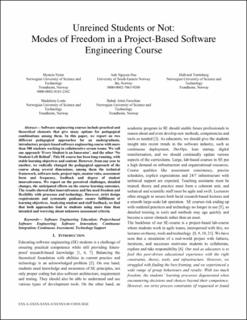Unreined Students or Not: Modes of Freedom in a Project-Based Software Engineering Course
Journal article
Accepted version

Åpne
Permanent lenke
https://hdl.handle.net/11250/2686014Utgivelsesdato
2020Metadata
Vis full innførselSamlinger
Originalversjon
2020 IEEE 32nd Conference on Software Engineering Education and Training (CSEE&T). 2020, . 10.1109/CSEET49119.2020.9206193.Sammendrag
Software engineering courses include practical and theoretical elements that give many options for pedagogical combinations among them. In this paper, we report on two different pedagogical approaches for an undergraduate, introductory project-based software engineering course with more than 500 students working in collaborative scrum teams. We call one approach ‘Every Student is an Innovator’, and the other ‘No Student Left Behind’. This SE course has been long-running, with stable learning objectives and content. However, from one year to another, we radically changed the pedagogical approach of the course along several dimensions, among them the technical framework, software tools, project topic, mentor roles, assessment form and frequency, feedback and degree of student innovativeness. We report on the perceived challenges, detailed changes, the anticipated effects on the course learning outcomes. The results showed that innovativeness and fun need freedom and flexibility with processes and technology. However, strict design requirements and systematic guidance ensure fulfillment of learning objectives. Analyzing student and staff feedback, we find that both approaches lead to students using more time than intended and worrying about unknown assessment criteria.